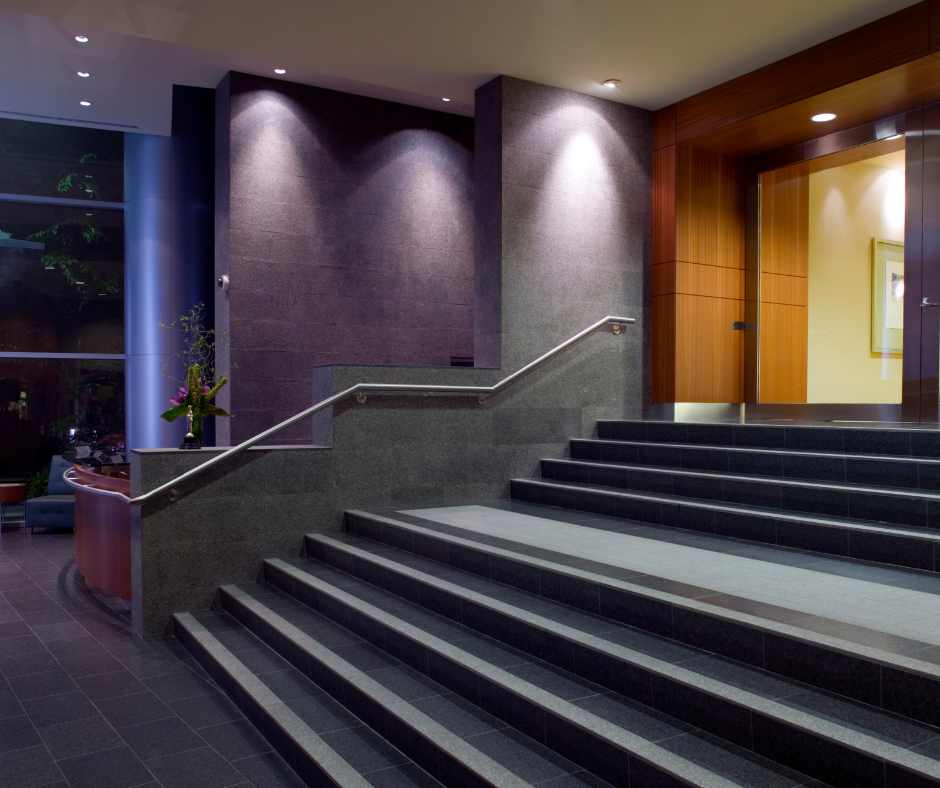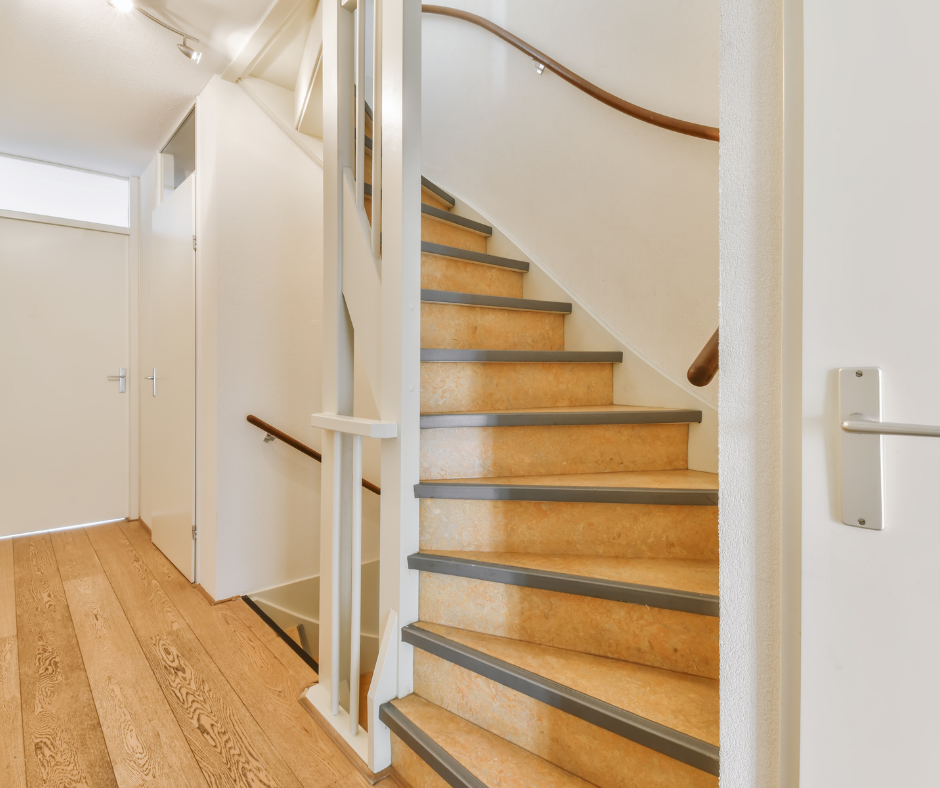Commercial staircases do more than connect floors—they protect everyone who uses them. When these stairs are built right, they feel solid and safe, whether you’re carrying a box or guiding a customer. Commercial stair tread depth is the measurement from the front to the back edge of each step, and it must be at least 11 inches deep to meet building codes and prevent trips and falls.
This guide explains exactly how commercial stair tread depth works, why it matters, and how carpet stair treads can affect the final measurements. You’ll learn the specific codes, design tips, and safety factors that set commercial stairs apart from residential ones. By the end, you’ll know how to choose or design stair treads that look great and keep every footstep secure.
What Size Are Commercial Stair Treads and Risers?
The International Building Code (IBC) is the main rulebook for commercial stairs. According to the IBC, stair treads must be at least 11 inches deep, while risers (the vertical parts) can’t be taller than 7 inches.
These measurements aren’t arbitrary—they’re carefully chosen to prevent trips and falls. By keeping the depth generous and the height modest, the code makes sure every step feels predictable and steady.
Picture a busy office or school stairwell. With dozens of people going up and down all day, the consistent tread size helps everyone—from employees carrying boxes to kids with backpacks—feel secure.
Why Are Commercial Stair Treads Different From Residential Ones?
If you’ve ever walked from a public building into someone’s home, you’ve probably noticed the stairs feel different. That’s because commercial stair treads are designed for heavier use.
Think of it like comparing a downtown sidewalk to your front walkway. A commercial staircase needs to:
-
Handle high foot traffic
-
Meet accessibility standards for people with disabilities
-
Remain safe even in emergencies
Residential stairs can be more customized to match the style of the home, with slightly smaller treads or taller risers. But in a commercial setting, consistency and safety come first.
Interior vs. Exterior Stair Tread Depth
Stairs inside a building aren’t always the same as those outside. Interior stair tread depth focuses on comfort and appearance while still meeting code requirements.
For example, in a hotel lobby, carpet stair treads might be installed to reduce noise and add a touch of luxury. These can slightly adjust the tread depth, so it’s important to factor them in during planning.
On the other hand, exterior stairs often need deeper treads or special surface treatments. Outdoor staircases must stay safe when rain, snow, or mud make surfaces slippery. That’s why exterior treads sometimes feature extra grip or drainage grooves to help everyone stay on their feet.
Extending Stair Tread Depth
Sometimes, standard dimensions aren’t quite enough. Extending stair tread depth can make sense in high-traffic areas or places where people often carry heavy or bulky items.
Longer treads provide:
-
More room to plant your foot securely
-
Easier movement for people using mobility aids
-
Extra safety when visibility is low
If you manage a commercial space like a hospital, stadium, or school, extending tread depth is a smart investment. Just be sure any adjustments still follow IBC and ADA requirements.
Compliance and Safety
The International Building Code (IBC), outlined in IBC Section 1011.5, is the gold standard for stair safety in commercial buildings across the United States. It spells out the minimum measurements every staircase must meet, so designers, builders, and facility managers all start from the same foundation. These requirements keep stairs predictable, comfortable, and safe for everyone who uses them.
IBC Requirements for Commercial Stair Treads (per IBC 1011.5):
-
Minimum tread depth: 11 inches (IBC 1011.5.2) measured horizontally from front to back
-
Maximum riser height: 7 inches (IBC 1011.5.2) measured vertically between steps
-
All steps within the same stairway must be identical in size and shape (IBC 1011.5.4)
Think of it like following a trusted recipe. If you skip ingredients or cha
Why Following the Code Matters
It’s tempting to think, “Close enough is good enough.” But when it comes to stairs, close enough isn’t safe enough.
Here’s why compliance is critical:
-
Prevent injuries. Uneven or undersized treads can cause trips, falls, and serious accidents.
-
Avoid legal issues. Non-compliant stairs can lead to lawsuits and insurance claims.
-
Protect your investment. Fixing code violations after construction is far more expensive than building correctly from the start.
By taking the time to get stair tread depth right, you’re not just ticking boxes—you’re caring for everyone who uses your building.
Factors That Influence Commercial Stair Tread Depth
No two staircases are exactly alike. Here are some of the most common factors that can affect tread depth:
-
Foot Traffic: Busy areas like airports, schools, and shopping centers benefit from deeper treads to improve flow and safety.
-
Building Type: Healthcare facilities and senior living centers often require additional space to support accessibility.
-
ADA Guidelines: The Americans with Disabilities Act (ADA) requires stairs to have uniform riser heights and tread depths to help prevent trips and falls. For commercial stairs, the ADA recommends a tread depth of at least 11 inches and riser heights no more than 7 inches, matching the IBC standards. These measurements ensure everyone, including people with mobility challenges, can move safely and confidently.
-
Finish Materials: Carpet, tile, or rubber coverings can slightly reduce usable tread space, so it’s important to plan accordingly.
-
Aesthetics: In some projects, design choices like overhangs or nosings influence final tread measurements.
Making the Right Choice for Your Stairs
Choosing the right stair tread depth doesn’t have to feel overwhelming. With clear standards and a little planning, you can create stairs that feel safe, sturdy, and stylish.
If you’re upgrading an existing staircase, look at whether extending the tread depth might help improve safety—especially in areas with lots of activity. For new builds, consult the IBC code and any state or local requirements to make sure every measurement is compliant.
Stepping It Up
At Oak Valley Designs, we believe stairs are more than just a way to get from one floor to the next. They’re the place where first steps happen, kids race each other, and neighbors stop by to share a laugh. Every tread should feel safe, comfortable, and built to last for the moments that matter most.
Whether you need commercial-grade carpet stair treads that hold up to heavy foot traffic or a custom solution that matches your building’s style, we’re here to make it easy. Our American-made products blend craftsmanship with thoughtful design, so you never have to sacrifice beauty for safety. Let us help you find the perfect fit for your space and the people who walk it every day.
Step Into Safer, Smarter Stairs Today
Whether you’re updating a busy commercial space or designing a new building from the ground up, the right stair tread depth makes all the difference. Oak Valley Designs is here to help you choose solutions that meet code, look beautiful, and keep everyone safe.
Contact us to explore our American-made stair treads or request a custom quote. Let’s build something you’ll be proud of.
-
Website: https://oakvalleydesigns.com/
-
Phone: (706) 331-0315
-
Email: info@oakvalleydesigns.com
-
Address: 30 River Ct SW Bldg E Cartersville, GA 30120




